How to Make Hydrogen Water?
Hydrogen water is regular water infused with molecular hydrogen, known for its potential health benefits like reducing inflammation and boosting energy. Its popularity is growing among health-conscious individuals and athletes.
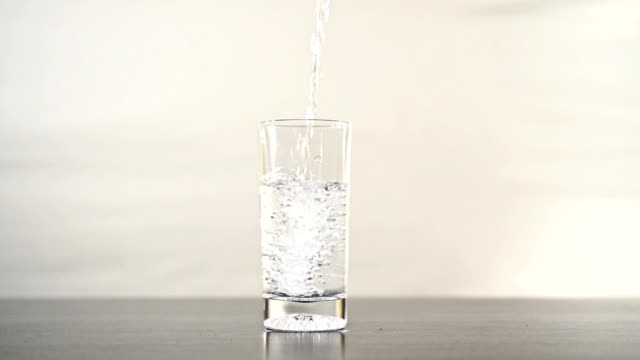
There are several ways to get hydrogen water, each with its own pros and cons. You can use hydrogen water machines for high-concentration water at home, portable bottles for convenience on the go, tablets for an easy and affordable solution, ready-to-drink options for ultimate convenience, or DIY methods for a more hands-on approach. Each method offers unique advantages, and choosing the right one depends on your needs and lifestyle.
By Hydrogen Water Machines
Hydrogen water machines are devices designed to infuse water with molecular hydrogen. These machines typically use electrolysis to split water molecules into hydrogen and oxygen, with the hydrogen being dissolved back into the water. The result is hydrogen-rich water, believed to have antioxidant properties that may contribute to various health benefits. These machines vary in complexity, ranging from countertop models to more compact, portable versions. Understanding their functionality is key to maximizing their use and ensuring you get the most out of your investment.
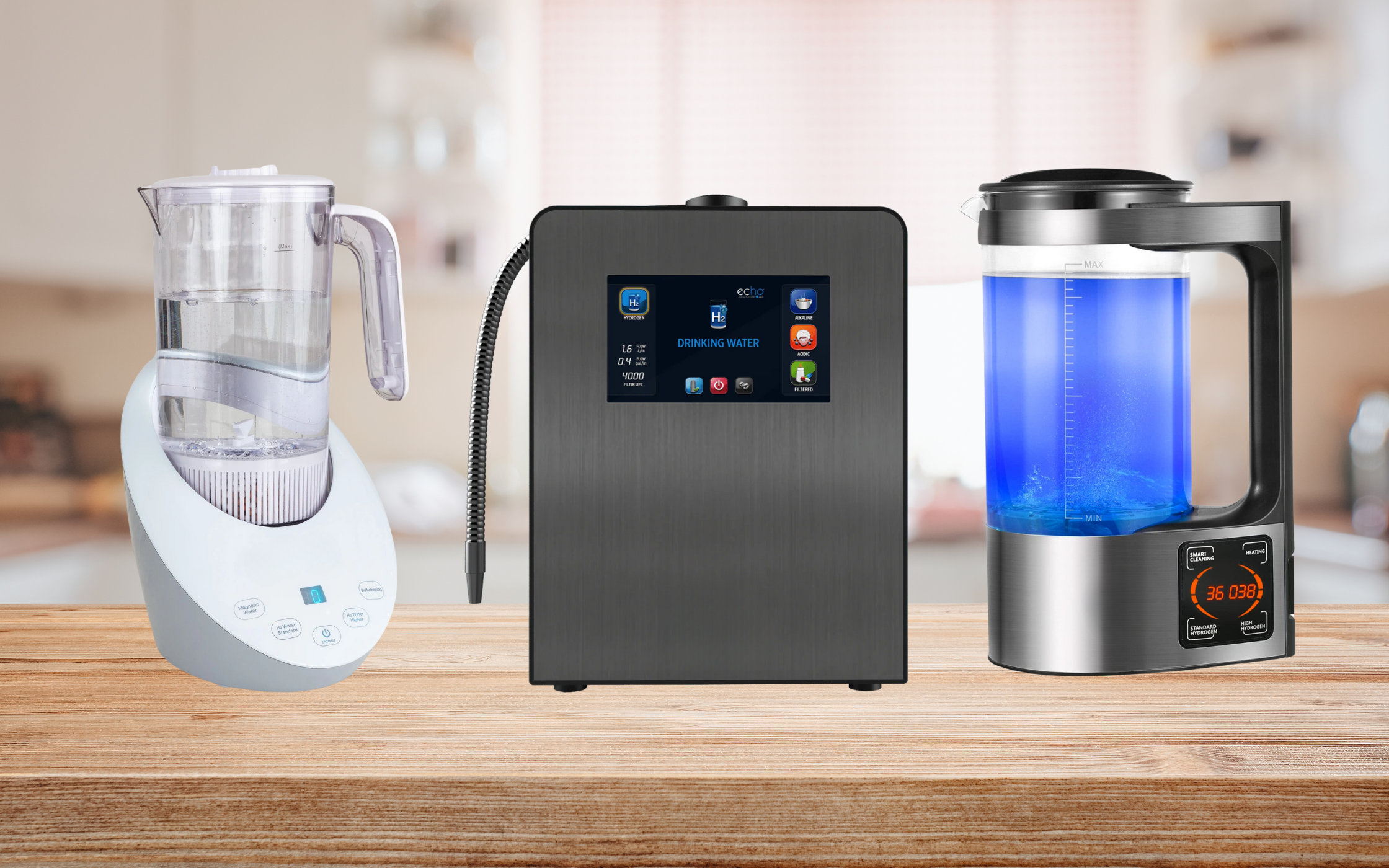
Pros:
- High Hydrogen Concentration: Machines often produce water with a higher hydrogen concentration compared to other methods, enhancing potential health benefits.
- Convenience: Once set up, they can produce hydrogen water continuously, making them ideal for regular use.
- Customizable Settings: Many machines allow users to adjust the concentration of hydrogen, offering more control over their intake.
Cons:
- Cost: Hydrogen water machines tend to be more expensive, with an initial investment that may be prohibitive for some users.
- Maintenance: These machines require regular maintenance, such as filter replacement and cleaning, which adds to the ongoing cost.
- Portability: Most machines are not portable, limiting their use to home settings.
Who It’s Ideal For
Hydrogen water machines are best suited for individuals who are committed to drinking hydrogen water regularly and value high-quality production. They are ideal for those looking for a consistent, reliable source of hydrogen water at home and who are willing to invest in a premium device. Regular users who prioritize health and wellness will find these machines particularly beneficial due to their ability to produce water with higher hydrogen concentrations.
Usage Guide
- Unbox and Inspect: Begin by unboxing the hydrogen water machine. Ensure all parts are present, including the power cord, water chamber, and any filters.
- Initial Setup:
- Placement: Place the machine on a flat, stable surface near a power outlet.
- Water Source: Fill the water chamber with clean, filtered water, as this ensures the best results.
- Filter Installation: Install the filter according to the manufacturer’s instructions. This step is crucial for maintaining water purity and ensuring the longevity of the machine.
- Power On and Select Settings:
- Plug in the machine and turn it on.
- Select the desired hydrogen concentration level. Most machines have preset options; choose the one that suits your needs.
- Start the Electrolysis Process:
- Activate the machine to start the hydrogen generation process. This typically takes a few minutes, during which the machine will infuse the water with hydrogen.
- Some machines have an indicator light or sound to signal when the process is complete.
- Pour and Consume:
- Once the water is ready, pour it into a glass or bottle. It’s best to drink the hydrogen water immediately to ensure maximum hydrogen retention.
- Maintenance Tips:
- Daily: Rinse the water chamber and wipe down the exterior to keep the machine clean.
- Weekly: Clean the water chamber thoroughly with mild soap and water. Rinse well to remove any soap residue.
- Monthly: Replace the filter if required, following the manufacturer’s guidelines. This ensures the water remains pure and the machine operates efficiently.
- Annually: Consider a full service or deep clean to maintain the machine’s performance and extend its lifespan.
By Hydrogen Water Bottles
Hydrogen water bottles are portable devices designed to generate hydrogen-rich water on the go. These bottles typically use electrolysis to infuse water with molecular hydrogen, similar to larger hydrogen water machines but in a compact, travel-friendly format. The process usually takes a few minutes, allowing you to enjoy hydrogen-enriched water wherever you are. They are particularly popular among those who prioritize convenience and want the benefits of hydrogen water while away from home.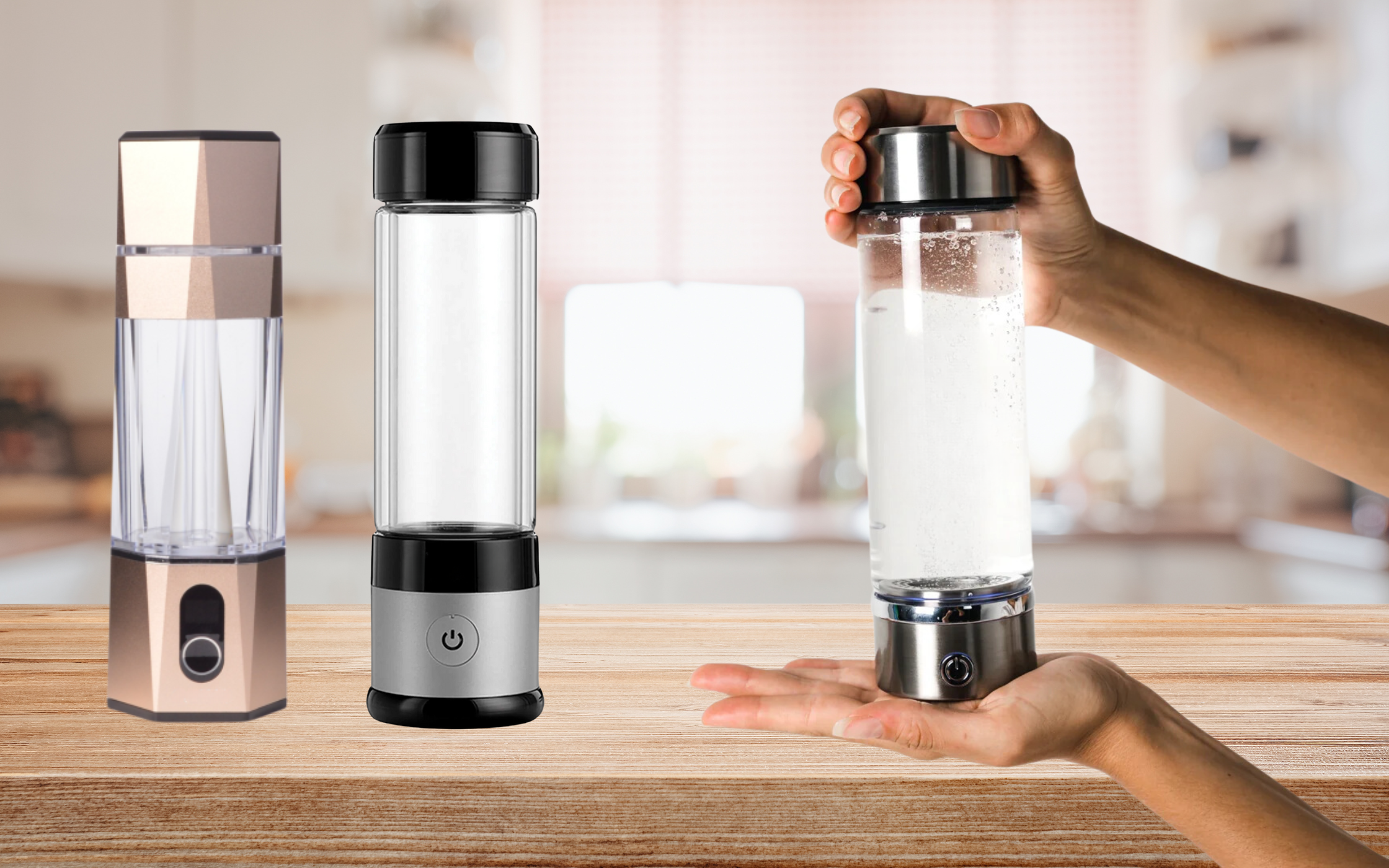
Pros:
- Portability: Hydrogen water bottles are lightweight and easy to carry, making them perfect for use at work, the gym, or while traveling.
- Convenience: These bottles allow you to generate hydrogen water whenever you need it, without relying on pre-packaged options.
- Cost-effective: Compared to buying ready-to-drink hydrogen water, using a bottle can be more economical in the long run.
Cons:
- Lower Hydrogen Concentration: Portable bottles may produce water with a slightly lower hydrogen concentration than larger machines.
- Limited Capacity: The smaller size means you may need to refill and generate hydrogen water multiple times a day, especially if you consume large quantities.
- Battery Maintenance: These bottles require regular charging, which can be an inconvenience if you forget to charge them.
Who It’s Ideal For
Hydrogen water bottles are ideal for individuals who lead active lifestyles and require a portable solution for hydrogen water. They are also perfect for those who want to start incorporating hydrogen water into their routine without investing in more expensive machines. If you value flexibility and convenience, a hydrogen water bottle might be the right choice for you.
Usage Guide
- Initial Setup:
- Charge the Bottle: Begin by charging the hydrogen water bottle fully using the provided USB cable. This ensures that the device is ready for use whenever needed.
- Inspect the Bottle: Check all parts of the bottle, including the electrolysis chamber, to ensure everything is in working order.
- Fill with Water:
- Use Clean Water: Fill the bottle with clean, filtered water up to the designated fill line. This maximizes the quality of the hydrogen water produced.
- Secure the Lid: Ensure the lid is tightly sealed to prevent any leaks during the hydrogen generation process.
- Generate Hydrogen Water:
- Activate the Bottle: Press the power button to start the electrolysis process. The bottle will typically take 3-5 minutes to generate hydrogen-rich water.
- Wait for Completion: Most bottles have an indicator light that will signal when the process is complete and the water is ready to drink.
- Consume Immediately:
- Drink the Water: Pour the hydrogen water into a glass or drink directly from the bottle. For best results, consume the water within 15-30 minutes to ensure maximum hydrogen content.
- Maintenance Tips:
- Daily: Rinse the bottle after each use to prevent residue buildup. Use mild soap if necessary.
- Weekly: Perform a deeper clean by disassembling the bottle (if possible) and washing all components. Ensure thorough rinsing to remove any soap.
- Battery Care: Recharge the bottle regularly to avoid running out of power when you need it most. A fully charged battery will typically last several uses.
- Filter Replacement: If your bottle uses a filter, replace it according to the manufacturer’s recommendations to maintain water purity.
By Hydrogen Water Tablets/Pills
Hydrogen water tablets or pills are a simple, portable method for generating hydrogen-rich water. These tablets work by dissolving in water, where they release hydrogen gas. The process is straightforward: when the tablet comes into contact with water, a chemical reaction occurs, producing molecular hydrogen that infuses the water. This method allows you to create hydrogen water without needing any special equipment, making it accessible and easy to use.
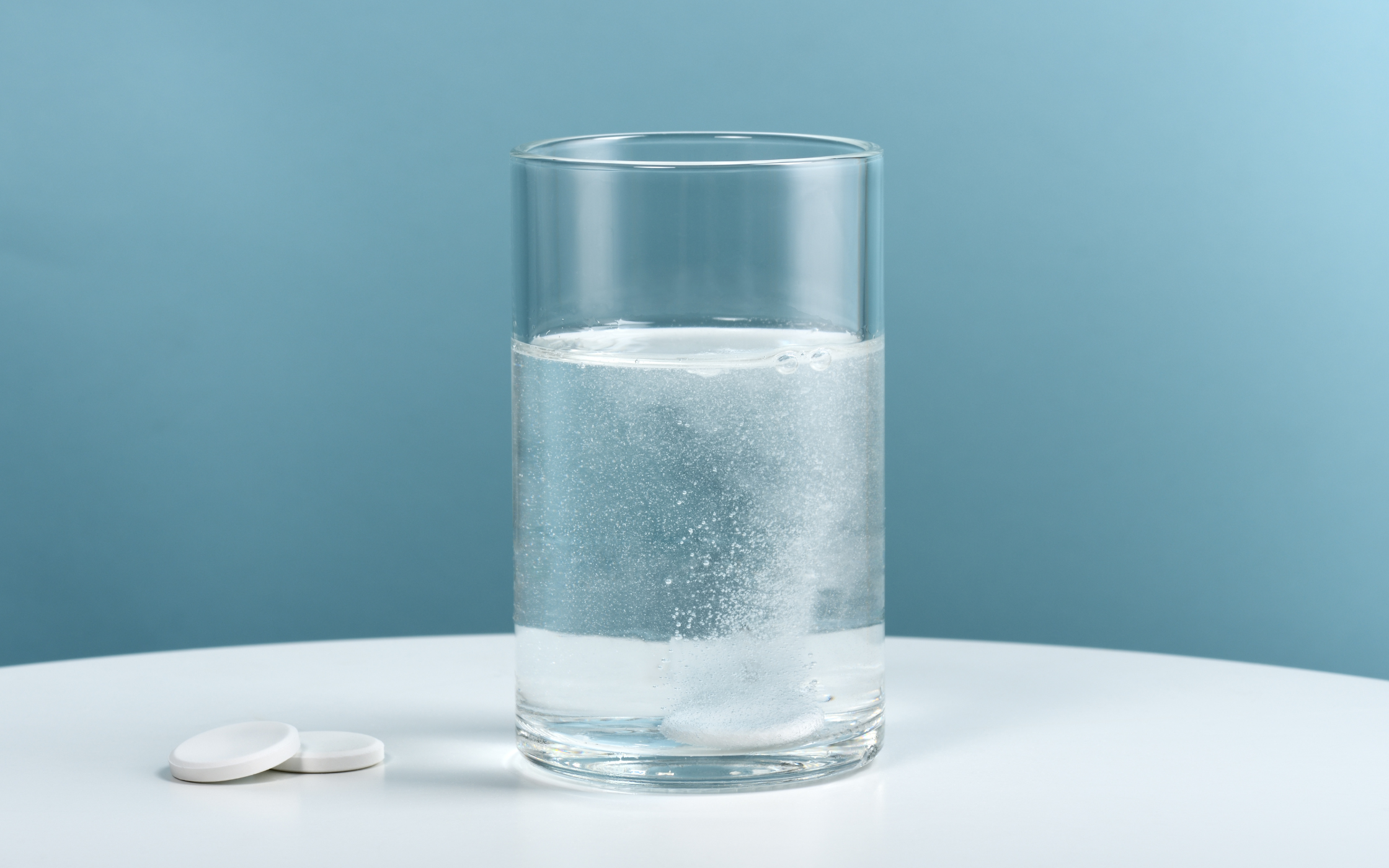
Pros:
- Convenience: Hydrogen water tablets are incredibly easy to use, requiring only a glass of water. They are ideal for on-the-go situations where you don’t have access to a hydrogen water machine or bottle.
- Portability: Tablets are compact and easy to carry, making them perfect for travel, work, or any situation where you need a quick hydrogen boost.
- Cost-effective: Compared to machines and bottles, tablets are generally more affordable, with lower upfront costs.
Cons:
- Variable Hydrogen Concentration: The concentration of hydrogen in the water can vary depending on the tablet’s formulation and the amount of water used, potentially leading to less consistent results.
- Taste: Some users may notice a slight change in the taste of the water, depending on the tablet’s ingredients.
- Limited Shelf Life: Tablets may have a limited shelf life, and their effectiveness can diminish over time if not stored properly.
Who It’s Ideal For
Hydrogen water tablets are ideal for beginners who are new to hydrogen water and want a simple, affordable way to start. They are also suitable for people who travel frequently or need a portable solution. If you’re looking for a quick, easy method to enjoy the benefits of hydrogen water without investing in more expensive equipment, tablets are an excellent choice.
Usage Guide
- Prepare the Water:
- Use a clean glass or bottle and fill it with 8-12 ounces of filtered water. The temperature should be between 10-25°C for optimal dissolution.
- Add the Tablet:
- Drop one hydrogen water tablet into the water. Avoid breaking or crushing the tablet, as this can affect the release of hydrogen gas.
- Allow Dissolution:
- Let the tablet dissolve completely. This typically takes 2-5 minutes. During this time, the tablet will release hydrogen gas, which infuses the water with molecular hydrogen.
- Consume Immediately:
- Once the tablet has fully dissolved, drink the water immediately to ensure you get the maximum hydrogen content. The hydrogen concentration in the water diminishes over time, so prompt consumption is key.
- Storage Tips:
- Store unused tablets in a cool, dry place, away from direct sunlight to maintain their effectiveness. Check the expiration date regularly and use the tablets before they lose potency.
By Ready-to-Drink Hydrogen Water
Ready-to-drink hydrogen water is pre-packaged hydrogen-enriched water, conveniently available for immediate consumption. This product is designed for those who want the benefits of hydrogen water without the need for any preparation. The water is typically packaged in airtight containers such as cans, bottles, or pouches to preserve the hydrogen content. Manufacturers ensure that the water remains hydrogen-rich from the point of packaging until it reaches the consumer, making it a convenient option for those on the go.
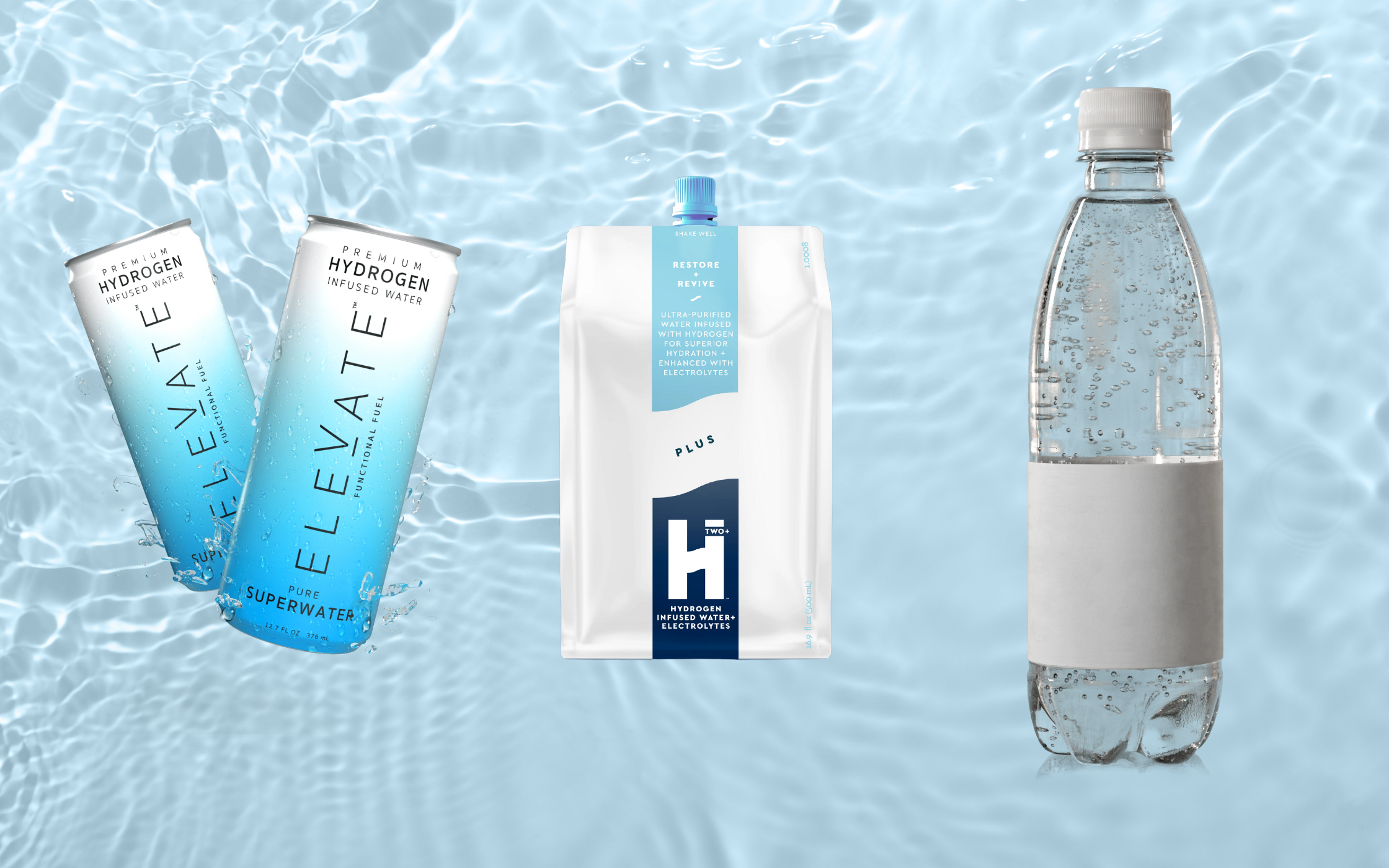
Pros
- Convenience: Ready-to-drink hydrogen water is the most convenient option, requiring no preparation. You simply open the container and drink.
- No Equipment Needed: There’s no need to invest in machines, bottles, or tablets, making it a hassle-free choice.
- Guaranteed Hydrogen Content: Since the water is sealed in airtight containers, you’re assured that the hydrogen concentration is maintained until you open it.
Cons
- Cost: Ready-to-drink hydrogen water is generally more expensive per serving compared to making hydrogen water at home.
- Limited Shelf Life: The hydrogen content can diminish over time, even in sealed containers, so it’s important to check expiration dates.
- Environmental Impact: The packaging used for ready-to-drink options, often single-use, can contribute to environmental waste.
Who It’s Ideal For
Ready-to-drink hydrogen water is ideal for individuals who prioritize convenience and are willing to pay a premium for it. It suits those with busy lifestyles who want to enjoy the benefits of hydrogen water without the hassle of preparation. This option is perfect for travelers, athletes, and anyone who wants a quick, reliable source of hydrogen water.
Usage Guide
- Check the Expiration Date:
- Always check the expiration date before consuming ready-to-drink hydrogen water. Hydrogen content may decrease as the product ages.
- Proper Storage:
- Store the containers in a cool, dark place away from direct sunlight. Exposure to heat and light can accelerate the degradation of hydrogen content.
- Chill Before Consumption:
- For optimal taste, refrigerate the water before drinking. Cold temperatures also help retain hydrogen longer.
- Consume Promptly:
- Once the container is opened, consume the hydrogen water immediately. Hydrogen gas starts to escape as soon as the seal is broken, reducing its potential benefits.
- Dispose of Packaging Responsibly:
- After consuming the water, recycle the container if possible. This helps reduce environmental impact.
By DIY Methods
DIY methods for making hydrogen water offer a budget-friendly approach for those interested in hydrogen water without investing in commercial machines or bottled products. These methods typically involve using magnesium sticks or electrolysis kits to generate hydrogen gas, which then dissolves into the water. Magnesium sticks, when immersed in water, react with the water to release hydrogen, while electrolysis kits split water molecules to produce hydrogen gas. These methods are popular among DIY enthusiasts who enjoy experimenting with different ways to create hydrogen water at home.
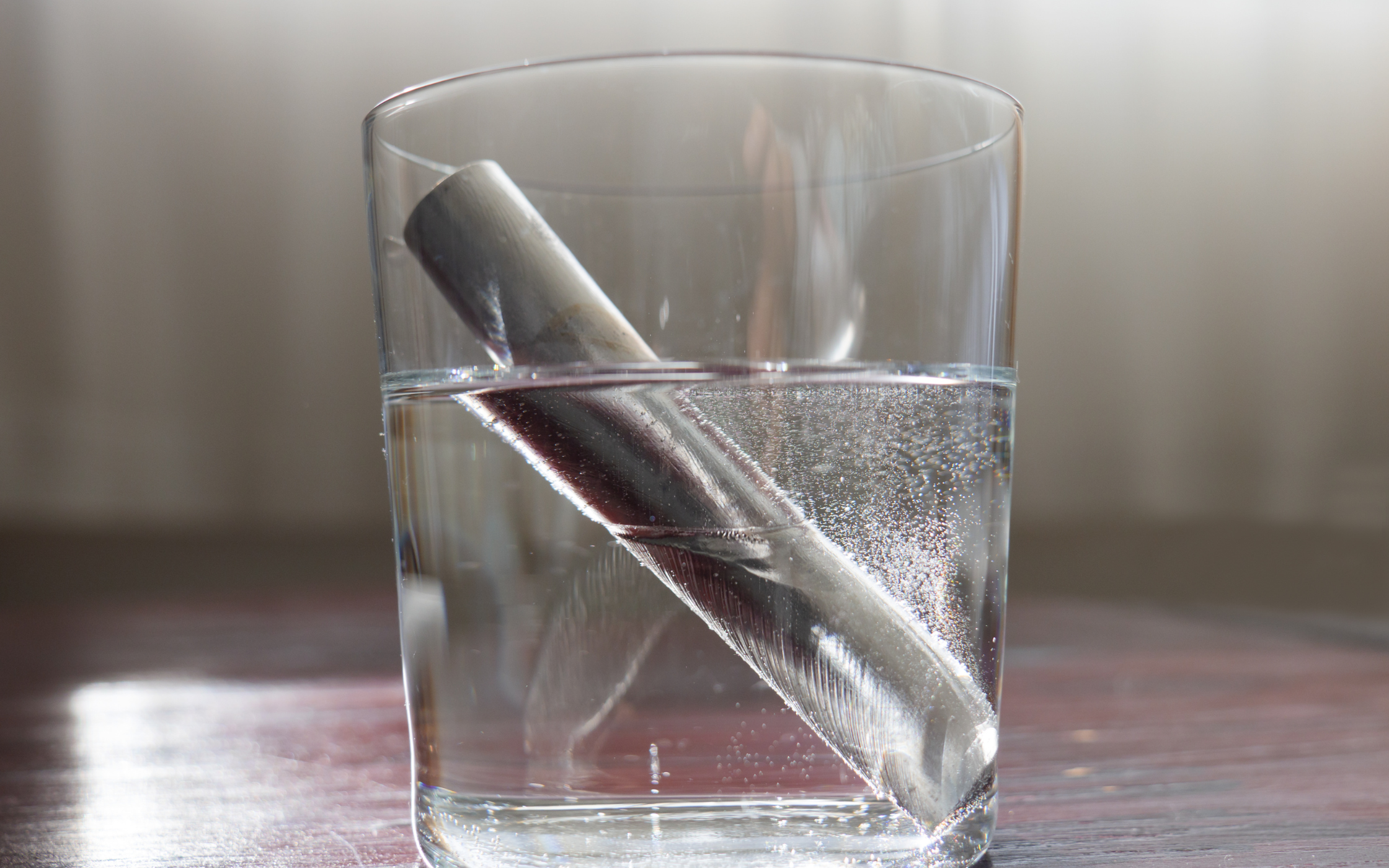
Pros:
- Cost-effective: DIY methods are generally cheaper than buying ready-made hydrogen water or investing in a machine.
- Customizable: You can experiment with different setups to find the method that best suits your needs and preferences.
- Educational: These methods offer a hands-on learning experience, making them appealing to those interested in the science behind hydrogen water.
Cons:
- Variable Results: The effectiveness of DIY methods can vary depending on the materials used and the precision of the setup, leading to inconsistent hydrogen concentration.
- Time-consuming: These methods often require more time and effort than using pre-packaged products or commercial machines.
- Safety Concerns: DIY methods, especially those involving electrolysis, may pose safety risks if not done correctly, such as improper handling of electrical components or materials.
Who It’s Ideal For
DIY hydrogen water methods are ideal for those who enjoy hands-on projects and are looking for a cost-effective way to produce hydrogen water. These methods are best suited for individuals who are comfortable with experimenting and have a basic understanding of the materials and processes involved. If you’re a DIY enthusiast or someone who values learning through experimentation, these methods could be an excellent fit.
Step-by-Step Guide
- Using Magnesium Sticks:
- Prepare the Materials: Obtain a food-grade magnesium stick and a clean container filled with filtered water.
- Immerse the Stick: Place the magnesium stick in the water. Make sure it is fully submerged.
- Wait for Hydrogen Release: Let the stick sit in the water for 5-10 minutes. As it reacts with the water, hydrogen gas will be released and dissolve into the water.
- Consume the Water: After the reaction is complete, drink the hydrogen-infused water immediately for the best results.
- Using Electrolysis Kits:
- Set Up the Kit: Follow the manufacturer’s instructions to assemble the electrolysis kit. This usually involves connecting the electrodes to a power source and placing them in water.
- Initiate Electrolysis: Turn on the power to start the electrolysis process. The kit will split water molecules, releasing hydrogen gas into the water.
- Monitor the Process: Allow the process to run for the recommended time (usually a few minutes), then turn off the power.
- Consume the Water: Once the hydrogen is fully dissolved, pour the water into a glass and drink it immediately.
Safety Precautions
- Handling Magnesium Sticks:
- Use food-grade magnesium sticks to avoid contamination.
- Store the sticks in a dry place to prevent premature reactions.
- Using Electrolysis Kits:
- Always follow the manufacturer’s instructions to avoid electric shock or damage to the kit.
- Ensure that the water used is safe and free of contaminants.
- General Safety Tips:
- Never leave DIY setups unattended while they are in operation.
- Keep children and pets away from your DIY hydrogen water setup to prevent accidents.
Factors to Consider When Choosing a Method
Cost
Initial Investment
The cost of producing hydrogen water varies widely depending on the method you choose:
- Hydrogen water machines typically require the highest initial investment, ranging from $200 to $500.
- Hydrogen water bottles are less expensive, generally priced between $50 and $200.
- Hydrogen water tablets offer a more affordable entry point, with a bottle of tablets costing around $20 to $50.
- Ready-to-drink hydrogen water is the most convenient but comes at a higher cost per serving, typically around $3 to $5 per bottle, packet or can.
- DIY methods, such as magnesium sticks or electrolysis kits, can be cost-effective, with kits ranging from $30 to $100.

Ongoing Costs
Consider the recurring costs associated with each method. Machines and bottles may require replacement filters every few months, adding to the overall expense. Tablets need to be replenished regularly, depending on usage. Ready-to-drink hydrogen water involves continuous purchasing, which can add up quickly over time, especially if consumed daily. DIY methods might involve occasional purchases of new magnesium sticks or other materials. Over time, these costs can add up, so it’s essential to factor them into your budget.
Convenience
Ease of Use
- Ready-to-drink hydrogen water is the most convenient, requiring no preparation – simply open and drink.
- Hydrogen water machines are generally easy to use once set up but are less portable, making them ideal for home use.
- Hydrogen water bottles offer the convenience of portability, making them suitable for use at work or while traveling.
- Tablets are the easiest to use, requiring only a glass of water and a few minutes of wait time.
- DIY methods might be less convenient, requiring more steps and time to achieve the desired result.

Time Commitment
Consider how much time you’re willing to spend each day on producing hydrogen water. Ready-to-drink options are the fastest, as they require no preparation. Machines and bottles are quicker once they’re set up, while tablets take a few minutes to dissolve. DIY methods can be more time-consuming, especially if you’re using electrolysis kits that require careful monitoring.
Hydrogen Concentration
Achievable Levels
The concentration of hydrogen in water varies depending on the method:
- Hydrogen water machines typically offer the highest concentration levels, often between 1.0 and 1.6 PPM (parts per million).
- Bottles also provide good concentration but may be slightly lower than machines.
- Tablets can produce varying concentrations depending on the brand and formulation, with some reaching similar levels to machines.
- Ready-to-drink hydrogen water is usually packaged to maintain a high concentration, but this can degrade over time, especially if not stored properly.
- DIY methods might produce lower and more inconsistent concentrations, especially if the process is not carefully controlled.
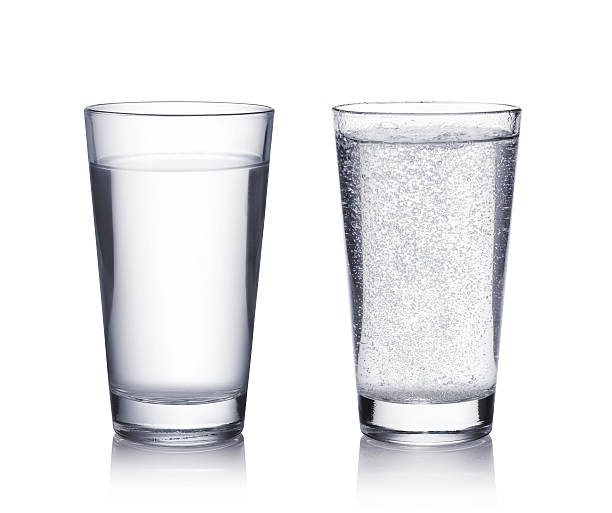
Impact on Health Benefits
Higher hydrogen concentration levels are believed to offer more significant antioxidant benefits. Therefore, if you are focused on maximizing these health benefits, investing in a machine or a high-quality bottle might be worth the higher cost. Tablets and DIY methods can still be effective but may not provide the same level of concentration consistently. Ready-to-drink options are convenient but should be consumed quickly to retain their benefits.
Maintenance
Cleaning and Upkeep
Regular maintenance is crucial for all methods to ensure the best results and longevity of the equipment:
- Machines require periodic cleaning of the water chamber and regular filter replacements.
- Bottles also need frequent cleaning, especially if used daily, and their filters may need to be changed every few months.
- Tablets require no maintenance, but you’ll need to purchase new tablets regularly.
- Ready-to-drink hydrogen water eliminates the need for maintenance, as it is pre-packaged and ready to consume.
- DIY methods may involve cleaning and replacing components, depending on the materials used.
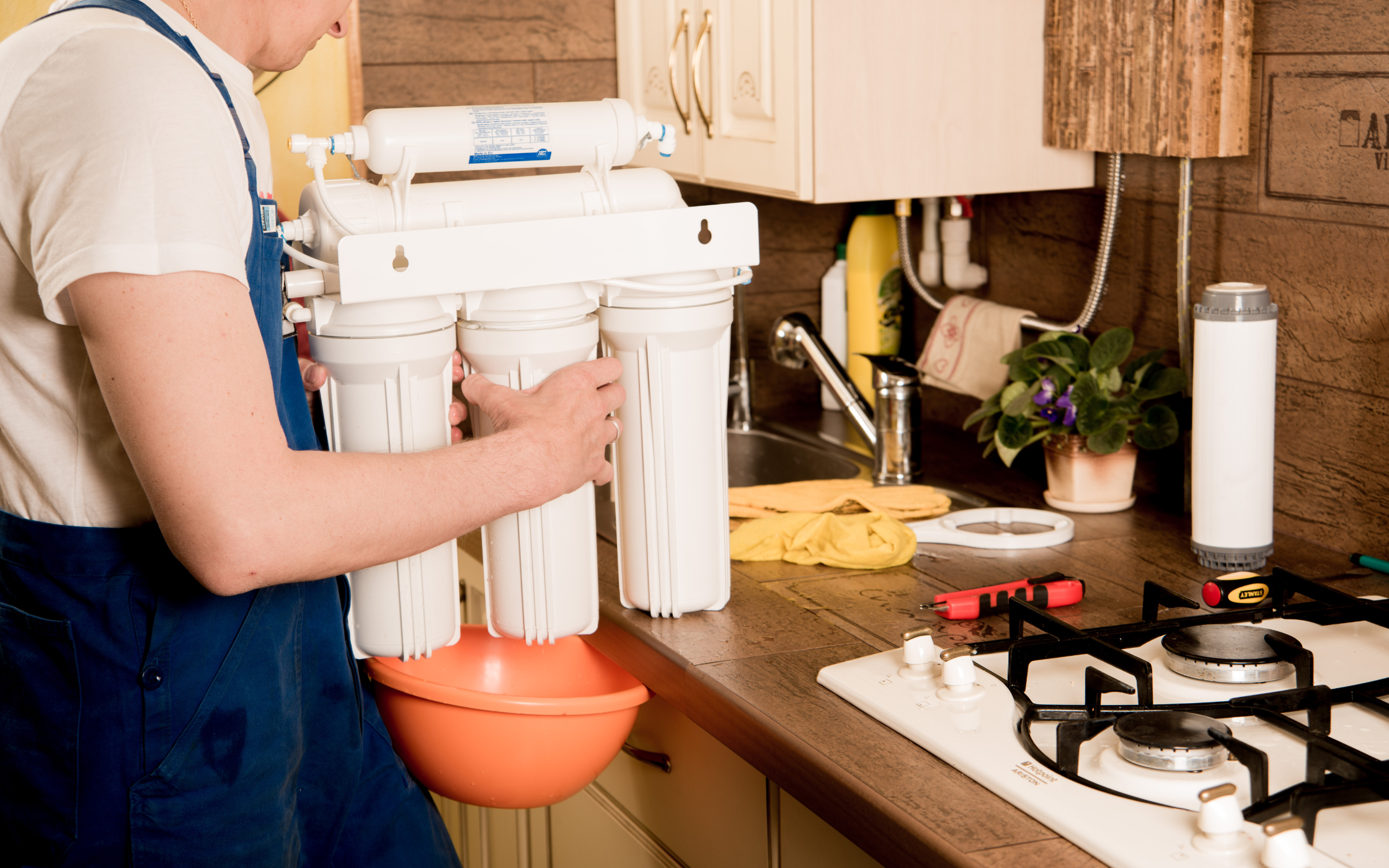
Battery and Filter Replacements:
For machines and bottles, batteries need regular recharging, and filters should be replaced according to the manufacturer’s instructions. Neglecting these tasks can reduce the water’s effectiveness and potentially damage the equipment. Ready-to-drink options do not require much maintenance, making them ideal for those looking for a hassle-free experience.
Safety
Certified Products:
Safety is a primary concern when dealing with hydrogen water production. Always use certified products that comply with safety standards. This is especially important for machines and bottles that involve electrical components. Certified products are tested for safety and effectiveness, reducing the risk of accidents.

Manufacturer Instructions:
Follow the manufacturer’s instructions carefully to avoid any potential hazards. For example, using the wrong type of water with a machine or failing to replace a filter on time can lead to malfunctions. In DIY methods, improper handling of materials like magnesium sticks or electrolysis kits can pose risks, so understanding and following the correct procedures is crucial.
Conclusion
We’ve covered several methods to make hydrogen water, including machines, portable bottles, tablets, ready-to-drink options, and DIY methods. Each has its benefits, depending on your lifestyle, budget, and health goals.
Ready to find your ideal hydrogen water solution? Visit our main website for top product recommendations and start your journey today.
FAQs
- What is the best method for making hydrogen water?
It depends on your needs. Machines offer the highest concentration, while bottles are portable. Tablets are affordable, and ready-to-drink options are the most convenient.
- How long does it take to make hydrogen water using different methods?
Machines: 3-10 minutes.
Bottles: 3-5 minutes.
Tablets: 2-5 minutes.
Ready-to-drink: Instant.
DIY methods: Varies.
- Is it safe to make hydrogen water at home?
Yes, if you use certified products and follow instructions.
- How long does hydrogen last in water?
Hydrogen lasts 15-30 minutes after production.
- Can I use regular water with hydrogen water methods?
Yes, but filtered or purified water is recommended.

I appreciate the author’s balanced approach. They don’t promote one method over another but encourage considering individual needs.